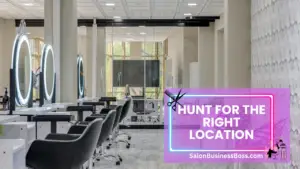Opening a hair salon can be an exciting and rewarding venture for those with a passion for hairstyling and beauty. However, starting a salon business requires careful planning and execution to ensure its long-term success.
To open up a hair salon, aspiring entrepreneurs should start by finding a mentor who can provide valuable guidance and expertise. Implementing robust accounting and inventory systems is crucial for financial management. The right location, tailored to the target clientele, ensures visibility and growth. Building a strong brand identity creates a lasting impression, while exceptional customer experiences and a skilled team foster success. Embrace ongoing learning, adapt to trends, and invest in marketing to attract and retain clients.
1. Find a Mentor:
In the pursuit of opening a hair salon, finding a mentor is an essential step that can shape your success. Mentors are experienced professionals within the hair industry who willingly share their knowledge and expertise. Their guidance can be invaluable, offering insights into salon management, team building, and overcoming challenges during the initial stages of establishment.
A mentor’s wisdom can accelerate your learning curve, helping you navigate complexities and avoid costly mistakes. They can provide practical advice on selecting the right salon location, creating a unique brand identity, and building a loyal customer base. Additionally, they may offer insights into managing finances, pricing services, and optimizing operational efficiency.
A mentor provides emotional support and motivation during the often daunting journey of starting a salon. Their encouragement can boost your confidence and keep you focused on your goals.
To find a mentor, attend industry events, networking gatherings, or approach established salon owners directly. Look for individuals whose values align with your own, and who have a track record of success in the hair industry. A nurturing mentor-mentee relationship can be a catalyst for your salon’s growth and prosperity.
2. Put an Accounting and Inventory Program in Place:
In the hair salon business, effective financial management is paramount for sustained success. Installing a robust accounting and inventory program from the outset is a fundamental step to stay on top of your salon’s financial health.
With the right software solution, you can accurately record and track your salon’s expenses, revenues, and inventory levels. This information empowers you to make informed decisions and identify areas for cost-saving opportunities.
An accounting system helps you monitor cash flow, manage payroll, and handle tax responsibilities efficiently. By maintaining transparent financial records, you’ll be better equipped to set pricing for services, assess profitability, and plan for the future.
Regarding inventory management, tracking stock levels of hair products, tools, and supplies is crucial to avoid overstocking or running out of essential items. An inventory program will help you streamline stock orders, minimize waste, and ensure smooth salon operations.
An organized accounting and inventory system enables you to prepare accurate financial reports, which may be required for seeking funding or attracting potential investors.
By prioritizing financial management through an effective software solution, you’ll lay a solid foundation for your hair salon’s growth and stability, setting the stage for long-term success in the competitive beauty industry.
3. Hunt for the Right Location:

Selecting the ideal location for your hair salon is a critical factor that can significantly impact its success. Conducting thorough market research is essential to identify areas with high demand for salon services and limited competition. Analyze demographic data to understand your potential customer base and their preferences.
Consider factors such as foot traffic and visibility. A location in a busy shopping district, near schools or offices, can attract more walk-in customers. Proximity to complementary businesses, such as beauty supply stores or boutiques, can also boost your salon’s visibility.
Parking availability is crucial, as customers may be deterred by limited parking options. Accessibility is equally important; a location with good public transportation links can attract a broader clientele.
Negotiating favorable lease terms is essential, especially in the early stages when your salon is establishing itself. A reasonable rent will free up financial resources for other essential investments, allowing your salon to grow without undue financial strain.
Remember that location decisions are not solely based on foot traffic and accessibility. Align your salon’s brand and concept with the neighborhood and its target market. A well-chosen location can create a positive first impression and foster a sense of community and loyalty among customers.
Read more about: How To Open a Successful Hair Salon
4. Build Your Salon Brand around the Clientele You Want:
Creating a strong and distinct salon brand is key to standing out in a competitive market. Start by defining your target clientele and understanding their preferences, lifestyle, and beauty needs. Tailor your salon’s ambiance, services, and decor to cater to their desires.
Whether your salon aims to attract high-end clients seeking luxurious experiences or young, trendy customers seeking cutting-edge styles, every element of your salon should reflect your brand identity. Invest in high-quality salon equipment, furniture, and décor that align with your chosen theme, creating an inviting and professional space that resonates with your target audience.
Consistency is vital in building a strong brand. Ensure that your marketing materials, social media presence, and customer interactions all reflect the brand image you want to convey. Engage with your target clientele through social media platforms and promotional events, showcasing your salon’s expertise and unique offerings.
Incorporate your brand message into your salon’s website, logo, and promotional materials, ensuring a cohesive and memorable identity. A well-defined salon brand that reflects the desires of your ideal clientele will attract a loyal customer base and set your salon apart from the competition.
5. Create an Unforgettable Customer Experience:
Providing an exceptional customer experience is the cornerstone of building a loyal and satisfied clientele for your hair salon. Train your salon staff to deliver top-notch services that go above and beyond customer expectations. Friendly and attentive service can make a lasting impression on clients, encouraging them to return and recommend your salon to others.
Offer personalized consultations to understand each client’s unique needs, preferences, and style aspirations. Actively listen to their concerns and provide expert advice and recommendations. This personalized approach helps create trust and rapport, making clients feel valued and understood.
Implement user-friendly online booking and appointment management systems to enhance customer convenience and reduce wait times. Modern clients appreciate the ease of scheduling appointments at their convenience, enhancing overall customer satisfaction.
Encourage customer feedback and actively respond to reviews, both positive and negative. Demonstrating a commitment to customer satisfaction and addressing concerns promptly can build trust and improve your salon’s reputation.
Create a warm and welcoming ambiance in your salon that fosters relaxation and comfort. From the reception area to the treatment spaces, attention to detail in decor and amenities enhances the overall experience.
6. Assemble a Talented and Passionate Team:
The success of a hair salon heavily relies on the expertise and dedication of its team. Recruit skilled hairstylists, colorists, and beauty experts who share your passion for delivering exceptional results. Thorough interviews and practical assessments will help identify candidates with the right skills and cultural fit for your salon.
Offer competitive compensation packages, including base pay, commissions, and benefits, to attract and retain top talent. Additionally, provide opportunities for professional growth and continuous education to encourage team members to improve their skills and stay updated on the latest trends and techniques.
Foster a positive work environment that encourages open communication and teamwork among your staff. A supportive culture that recognizes and celebrates achievements creates a motivated and cohesive team.
Regularly conduct performance evaluations and provide constructive feedback to help your team members enhance their skills and maintain high standards of service.
Encourage collaboration among your team members, as their collective creativity and expertise can lead to innovative services and solutions. A talented and passionate team creates a vibrant and dynamic salon, contributing to customer satisfaction and the salon’s long-term success.
7. Marketing and Promotions:

Effective marketing is crucial to attract a steady stream of customers and establish brand recognition for your hair salon. Utilize a combination of digital and traditional marketing strategies to reach your target audience effectively.
Create an engaging website that showcases your salon’s services, pricing, and contact information. Ensure that the website is mobile-friendly and easy to navigate. Implement a booking system that allows clients to schedule appointments online conveniently.
Leverage the power of social media platforms to showcase your salon’s expertise and creativity. Share before-and-after transformation photos, customer testimonials, and behind-the-scenes glimpses of your salon’s daily operations. Engage with your audience through posts, stories, and live videos to build a strong online presence.
Collaborate with local influencers or partner with nearby businesses for cross-promotional activities. Partnering with influencers can expose your salon to a wider audience, while collaborations with neighboring businesses can create a sense of community and attract more foot traffic.
Offer introductory discounts or loyalty programs to entice new customers and reward loyal ones. Discounts for first-time visitors can encourage trial and conversion, while loyalty programs can foster customer retention and repeat business.
Utilize email marketing to stay connected with your customers and keep them informed about special offers, promotions, and upcoming events. Personalize your email campaigns based on customers’ preferences and past interactions with your salon.
Remember to track the effectiveness of your marketing efforts through analytics and customer feedback. Analyzing data will help you refine your strategies and ensure you allocate resources to the most successful marketing channels.
Read more about: Style Reimagined: Fresh Hair Salon Grand Opening Concepts
8. Embrace Ongoing Learning and Adaptation:
The hair industry is constantly evolving, with new trends, techniques, and technologies emerging regularly. To stay competitive and deliver top-notch services, embrace ongoing learning and adaptation.
Attend workshops, seminars, and industry events to stay updated on the latest developments and industry best practices. These events provide opportunities to learn from industry experts, network with peers, and discover innovative trends.
Encourage your salon team to participate in educational programs and training sessions. Providing opportunities for skill enhancement and creativity will improve the quality of services your salon offers.
Be receptive to customer feedback and market trends. Solicit feedback from clients and use it to improve your salon’s services and customer experience. Stay attuned to market demands, and adapt your offerings and services accordingly.
Embrace technology and incorporate the latest tools and equipment that can enhance your salon’s efficiency and service quality. For example, consider incorporating advanced hair treatments or eco-friendly products if there’s a growing demand for such services.
A hair salon that evolves with the times and continuously seeks improvement will remain relevant and attract a diverse clientele. By staying at the forefront of industry developments, your salon will build a reputation as a progressive and forward-thinking establishment.
Conclusion
Opening a hair salon is a challenging yet rewarding endeavor for entrepreneurs passionate about the beauty industry. By finding a mentor, implementing effective financial systems, choosing the right location, building a strong brand, and prioritizing customer satisfaction, you can set the foundation for a successful hair salon. Remember that success may not happen overnight, but with dedication, hard work, and a commitment to continuous improvement, your hair salon can become a beloved destination for your target clientele, and your entrepreneurial dreams will become a reality.
Frequently Asked Questions

1. How can I stand out from competitors?
Define a unique brand identity, offer specialized services, create a welcoming ambiance, and prioritize outstanding customer care.
2. Do I need to invest in salon management software?
Salon management software can streamline appointments, inventory, and employee scheduling, improving efficiency and customer experience.
3. How can I stay updated on industry trends?
Attend industry events, workshops, and conferences. Follow fashion magazines and social media influencers for the latest hair trends.
To learn more on how to start you own salon checkout my startup documents here.
Please note that the contents of this blog are for informational and entertainment purposes only and should not be construed as legal advice. Any action taken based on the information provided in this blog is solely at your own risk. Additionally, all images used in this blog are generated under the CC0 license of Creative Commons, which means they are free to use for any purpose without attribution.

About the author. Entrepreneur and Salon Business Fan.
Hi! I am Shawn and I am a happy individual who happens to be an entrepreneur. I have owned several types of businesses in my life from a coffee shop to an import and export business to an online review business plus a few more and now I create online salon business resources for those interested in starting new ventures. It’s demanding work but I love it. I do it for those passionate about their business and their goals. That’s why when I meet a salon business owner, I see myself. I know how hard the struggle is to retain clients, find good employees and keep the business growing all while trying to stay competitive.
That’s why I created Salon Business Boss: I want to help salon business owners like you build a thriving business that brings you endless joy and supports your ideal lifestyle.


